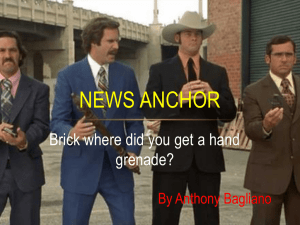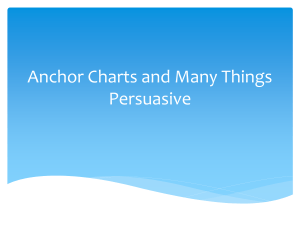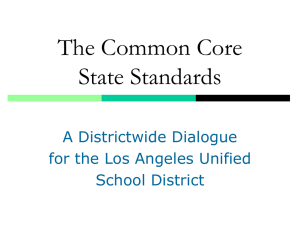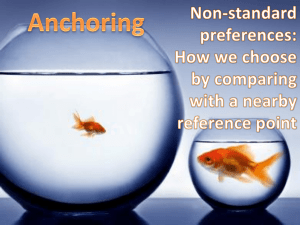Content
advertisement
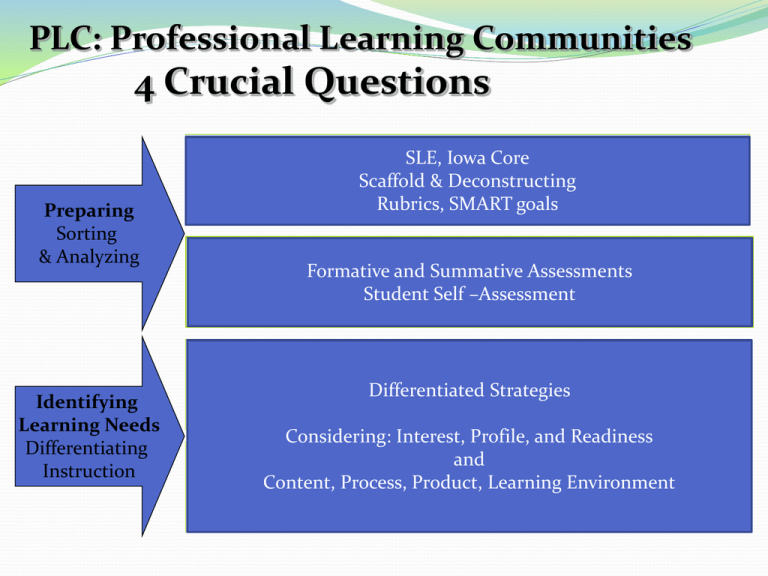
PLC: Professional Learning Communities 4 Crucial Questions Preparing Sorting & Analyzing Identifying Learning Needs Differentiating Instruction SLE, Iowa each Core What do we want student Scaffold & Deconstructing Rubrics, or SMART goals to learn, know, be able to do? What evidence do we have of Formative and Summative Assessments Student Self –Assessment the learning? How will we respond when some Differentiated Strategies students don’t learn? Considering: Interest, Profile, and Readiness and Content, Process, Product, Learning Environment How will we respond to those who have already learned? Role of Assessment Cassandra Erkens, 2008 Anam Cara Consulting, Inc http://www.anamcaraconsulting .com Wall Space at a Premium! With your table team (a little friendly competition): List objects on your classroom walls – 2 min. Do not include those items that are teacher only – your duty schedule Anchors are a source of stability and security. Thrown overboard, the anchor stables the boat holding it firmly in a desired location. Likewise, an Anchor Chart displayed in a classroom learning community anchors student thinking while offering a source of visual reference for continued support as the learner moves forward. Anchor Charts Three Types of Differentiating Content-what students will learn and the materials that represent that learning Process-methods students use to make sense of the content Product-what the students do to demonstrate learning Individual Anchor Charts Resources that students use to support their learning needs Explicitly taught on how to use and find the information need to expand learning Easily differentiated to meet needs Examples: 100’s charts, writing folders, phonics sound sheet, timeline Anchor Charts – Content Content – anchoring information, understanding, concepts Source: http://lilac.edublogs.org/classroomdisplays/ Content Anchor Charts Source: http://lizslessons.blogspot.com/2011/11/novemberinstructional-resource-update.html Anchor Charts – Three Types Process –anchoring procedure, sequence, how-to http://mathhombre.blogspot.com/2009/10/anchorcharts.html Source: http://working4theclassroom.blogspot.com/ p/teachers-resources.html Process Anchor Charts Anchor Charts – Three Types Product – anchoring purposeful independent work Anchor Charts – Three Types Content – anchoring information, understanding, concepts Process –anchoring procedure, sequence, how-to Product – anchoring purposeful independent work Wall Sort Anchor Activities Purposeful practice that is engaging, motivating, and at the independent learning level Represents learning that has been directly taught, but now can be done without teacher guidance Change activities as expectations change Frees up teachers to work with small group Connection to Daily 5-Reading Students make choices of activities Read to self Read to someone Listen Write Word work The choices are anchor activities, they can do them independently and continue learning. Anchor Ideas Writing journals Creative writing prompts Independent reading Content-related reading Reading games and activities Math games Spelling practice Vocabulary activities Art activities tied to content Music tied to content Independent projects or studies Small-group projects Extensions Other to fit with curriculum How Do I Get Started? 1. Teach the whole group to work on an anchor activity independently and quietly. The teacher is not a contact person at this time. 2. Progress to one group on an anchor activity and another group on an another activity - then flip flop groups. This may be done later in the day or in backto-back time slots. Example - One group may be working with the teacher on math manipulatives while the other group works independently on anchor activities. How Do I Get Started? 3. Progress to 1/3 of the class on anchor activities, 1/3 involved in a teacher directed activity and 1/3 working at mini lab on a curriculum related unit. 4. Move to the next stages only when your students are ready. Length of time can be increased at the second stage before moving on to the third stage. Must Do-May Do Balance of what is non-negotiable and what is student selected Expand the initial understanding by synthesizing and creating new variations that enhance learning Must have clear expectations and outcomes May Do’s vary and do not always address the same How do I manage it? Monitoring for learning What procedures need to be in place for this to be successful? Anchor Critera: o Appropriate o Engaging o Reinforce or make new connections o Provide a different pathway o Appropriate challenge level o Practice in short chunks to build endurance with students o Able to Self-assess Questions to Ask When Preparing Anchor Activities… What SLE’s will be emphasized? How is the activity differentiated to meet the needs in the class? What instruction needs to happen so students can do it independently? What materials will be needed to be engaged? Helpful Websites: Working 4 the Classroom – Classroom Anchor Charts and Posters http://working4theclassroom.blogspot.com/p/teachers- resources.html School Anchor charts by Alison Voakes http://pinterest.com/alisonvoakes/school-anchor-charts/ Anchor chart – Writing http://pinterest.com/pin/204069426835435492/ Hundreds of examples Google: Anchor charts, anchor charts for middle school, anchor charts for….. Reflection If…then… Individual Profile Interests Readiness Content Process Product Learning Environment

